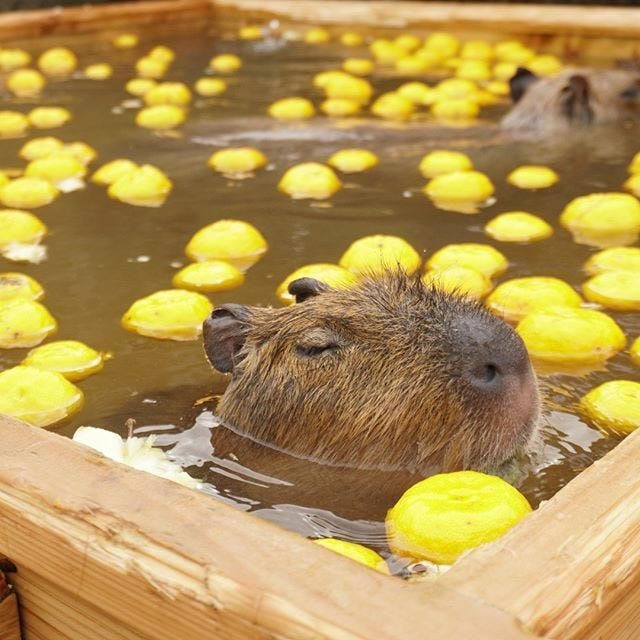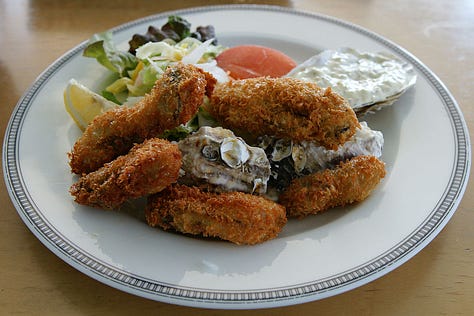December 2 - 6
橘始黄
たちばなはじめてきばむ
Tachibana hajimete kibamu
”Tachibana citrus trees ripen”
It is said in the Kojiki—Japan’s oldest book containing myths and legends about its formation—that the citrus fruit was first brought to Japan by Tajimamori, who crossed to the Lands Beyond1 to retrieve them for the Emperor Suinin. Tajimamori would come to be worshipped as the God of Sweets, and those first citrus fruits were called tachibana.
Said to be the ancestor of all citrus in Japan, the tachibana (橘) is a wild citrus fruit that grows up and down the Japanese archipelago. Over thousands of years, they were cultivated into a variety of different tasty varieties, such as the well known mikan (蜜柑, mandarin or “satsuma orange”) and yuzu (柚子). So the myth isn’t wholly fantasy. Like most, it likely derived from oral history that just picks up a bit of extra flavor along the way.
The fruit that Tajimamori was tasked to bring back was named in the legend as tokijiku-no-kakunomi (非時香菓), which was said to grant eternal youth and longevity, and whose kanji characters could be translated as “fruit of timeless fragrance.” And indeed one of the characteristic factors that are prized in Japanese citrus are their strong aromatic qualities.
Several hot springs offer mikan and yuzu baths, with whole fruits bobbing in the warm waters, and there’s plenty of guides online for enjoying it at home (hint: put whole fruit into the bath and you’re done). Such baths are said to increase blood flow and stave off colds and other illness as the weather gets colder.
The most traditional time to take a fruit-full dip is on the Winter Solstice2 but you can find places advertising it all throughout the winter months, including zoos which famously set up seasonal baths for capybaras (an animal native to humid tropical rainforests and unused to cold, dry winters).


Although its eventual progeny became more famous—and, well, edible—the tachibana still retains an important place in Japanese culture. The tree is evergreen, and has been planted at shrines as an auspicious symbol of health and vitality since at least the Heian Period (8th century CE). Perhaps the most famous of which is the Ukon-no-tachibana (右近の橘), which stands near the stairs leading to the Kyoto Imperial Palace’s ceremonial hall. This specific tree served as the inspiration for the badge bestowed upon those awarded the Order of Cultural Merit.
Acknowledging contributions to Japanese culture through the arts and sciences, the Order is one of the few honors granted directly by the Emperor, in a ceremony that takes place at the Palace each year on Culture Day (appropriately). Past recipients have included the director Akira Kurosawa, the architect Tadao Ando, and the Japanologist Donald Keene. 2023’s recipients include a calligrapher, a professor of economics, a playwright, a biologist, and a Noh theater performer. Famously, it was turned down by the novelist Kenzaburō Ōe, a Nobel Prize winner and vocal critic of the Empire.
Having spent the year fully absorbing the Sun’s warmth, Japanese citrus bring a bit of welcome sweetness into the winter. In fact, the kanji character 菓, which now often means “fruit,” originally referred to all sweets and desserts, and is still present in the word okashi (お菓子), meaning candy or confections. The citrus sweetness that Tajimamori brought to Japan in those ancient mythical times can still be enjoyed today, and forms an important part of Japanese winter.
Of course, sweets are best had after a meal, so what would be best during Kō 60? I’m glad you asked.
● Seasonal shellfish
kaki, 牡蠣, oyster● Seasonal non-shellfish
tara, 鱈, cod● Seasonal flower
biwa, ビワ, loquat flower



Although the world of sweets has advanced a great deal in the centuries since that royal fruit-finding mission, it can be hard to beat the classics. Even today, no shortage of Japanese households will have a nice plate of mandarins stacked on the table for snacking. In fact, no New Years celebration would be complete without it.
If you happen to grab a bag for yourself, give a little thanks to Tajimamori and the tachibana.
See you next kō~
I think it would be a nice little goal to reach 150 subscribers by the end of this year, so if you know someone who might enjoy learning esoteric tidbits about Japan in this way please feel free to put in a good word — we’re only 9 away at the moment!
[Images & info by kurashikata.com, kurashi-no-hotorisya.jp, 543life.com, and Wikipedia except where otherwise noted]
Genomic evidence suggests the Ryukyu Islands (modern day “Okinawa”) as their origin
December 21st this year, for Japan and the rest of the Northern Hemisphere








